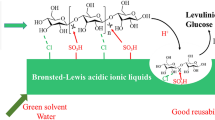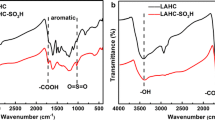Abstract
Herein, one-step conversion of cellulose dissolved in 1.75 mol L−1 NaOH/0.074 mol L−1 ZnO aqueous solution to organic acids was realized through a hydrothermal degradation without heterogeneous catalyst. The effects of solvent, the concentrations of NaOH and ZnO, O2 pressure, temperature and the reaction time on the yield of organic acids were investigated and discussed. The components of the degraded products were characterized with total organic carbon and high performance liquid chromatography. The results indicated that cellulose was depolymerized successfully to organic acids. Formic acid as the predominant species with 80.0% yield was obtained at the optimal conditions (150°C, 2 h, 3.0 MPa O2), which was much higher than those reported in literatures. The small amount of ZnO in the solvent played an important role not only to promote the cellulose dissolution, but also to accelerate its oxidative degradation. The main features of this one-step degradation of cellulose were the green solvent, pre-dissolution of catalyst, and high selectivity. This work opened up a new avenue for the conversion of cellulose to organic acids under mild conditions.
Graphical abstract
The oxidative degradation of cellulose dissolved in NaOH/ZnO aqueous solution into organic acids was conducted under pressed O2 without heterogeneous catalyst. The yield of FA which was the main product reached up to 80.0%.







Similar content being viewed by others
References
Bavykina A, Goesten M, Kapteijn F, Makkee M, Gascon J (2015) Efficient production of hydrogen from formic acid using a Covalent Triazine Framework supported molecular catalyst. Chemsuschem 8:809–812
Cai J, Zhang L (2005) Rapid dissolution of cellulose in LiOH/urea and NaOH/urea aqueous solutions. Macromol Biosci 5:539–548
Cai J, Liu Y, Zhang L (2006) Dilute solution properties of cellulose in LiOH/urea aqueous system. J Polym Sci, Part B: Polym Phys 44:3093–3101
Cantero DA, Tapia ÁS, Bermejo MD, Cocero MJ (2015) Pressure and temperature effect on cellulose hydrolysis in pressurized water. Chem Eng J 276:145–154
Chen LH, Wang QQ, Hirth K, Baez C, Agarwal UP, Zhu JY (2015) Tailoring the yield and characteristics of wood cellulose nanocrystals (CNC) using concentrated acid hydrolysis. Cellulose 22:1753–1762
Choudhary H, Nishimura S, Ebitani K (2015) Synthesis of high-value organic acids from sugars promoted by hydrothermally loaded Cu oxide species on magnesia. Appl Catal B 162:1–10
Ding LN, Wang AQ, Zheng MY, Zhang T (2010) Selective transformation of cellulose into sorbitol by using a bifunctional nickel phosphide catalyst. Chemsuschem 3:818–821
Gan L, Zhu J, Lv L (2017) Cellulose hydrolysis catalyzed by highly acidic lignin-derived carbonaceous catalyst synthesized via hydrothermal carbonization. Cellulose 24:1–13
Gao P, Li G, Yang F, Lv X, Fan H, Meng L, Yu X (2013) Preparation of lactic acid, formic acid and acetic acid from cotton cellulose by the alkaline pre-treatment and hydrothermal degradation. Ind Crop Prod 48:61–67
Geng C, Hu X, Yang G, Zhang Q, Chen F (2015) Mechanically reinforced chitosan/cellulose nanocrystals composites with good transparency and biocompatibility. Chin J Polym Sci 33:61–69
Gustafsson Ö, Kruså M, Zencak Z, Sheesley RJ, Granat L, Engström E, Praveen PS, Rao PP, Leck C, Rodhe H (2009) Brown clouds over South Asia: biomass or fossil fuel combustion? Science 323:495–498
Haerens K, Matthijs E, Chmielarz A, Van der Bruggen B (2009) The use of ionic liquids based on choline chloride for metal deposition: a green alternative? J Environ Manag 90:3245–3252
Iguchi M, Himeda Y, Manaka Y, Matsuoka K, Kawanami H (2016) Simple continuous high-pressure hydrogen production and separation system from formic acid under mild temperatures. Chemcatchem 8:886–890
Jia B, Mei Y, Cheng L, Zhou J, Zhang L (2012) Preparation of copper nanoparticles coated cellulose films with antibacterial properties through one-step reduction. ACS Appl Mater Interfaces 4:2897
Jiang Z, Lu A, Zhou J, Zhang L (2012) Interaction between-OH groups of methylcellulose and solvent in NaOH/urea aqueous system at low temperature. Cellulose 19:671–678
Jiang Z, Zhang Z, Song J, Meng Q, Zhou H, He Z, Han B (2016) Metal-oxide-catalyzed efficient conversion of cellulose to oxalic acid in alkaline solution under low oxygen pressure. ACS Sustain Chem Eng 4:305–311
Kit Chapman (2016) Chemistry world, Oct, https://www.chemistryworld.com/careers/the-cellulose-specialist/1017336.article
Liu W, Budtova T, Navard P (2011) Influence of ZnO on the properties of dilute and semi-dilute cellulose-NaOH-water solutions. Cellulose 18:911–920
Liu Y, Luo C, Liu H (2012) Tungsten trioxide promoted selective conversion of cellulose into propylene glycol and ethylene glycol on a ruthenium catalyst. Angew Chem 124:3303–3307
Luterbacher JS, Rand JM, Alonso DM, Han J, Youngquist JT, Maravelias CT, Pfleger BF, Dumesic JA (2014) Nonenzymatic sugar production from biomass using biomass-derived γ-valerolactone. Science 343:277–280
Mirzaei HM, Karimi B (2016) Sulphanilic acid as a recyclable bifunctional organocatalyst in the selective conversion of lignocellulosic biomass to 5-HMF. Green Chem 18:2282–2286
Qi H, Yang Q, Zhang L, Liebert T, Heinze T (2011) The dissolution of cellulose in NaOH-based aqueous system by two-step process. Cellulose 18:237–245
Su J, Qiu M, Shen F, Qi X (2018) Efficient hydrolysis of cellulose to glucose in water by agricultural residue-derived solid acid catalyst. Cellulose 25:17–22
Swatloski RP, Spear SK, Holbrey JD, Rogers RD (2002) Dissolution of cellulose with ionic liquids. J Am Chem Soc 124:4974–4975
Vaquerizo L, Abad-Fernández N, Mato RB, Cocero MJ (2018) Redefining conventional biomass hydrolysis models by including mass transfer effects. Kinetic model of cellulose hydrolysis in supercritical water. Chem Eng J 350:463–473
Wang Y, Deng WP, Wang BJ, Zhang QH, Wan XY, Tang ZC, Wang Y, Zhu C, Cao ZX, Wang GC, Wan HL (2013) Chemical synthesis of lactic acid from cellulose catalyzed by lead (II) ions in water. Nat Commun 4:2141
Wang G, Tan X, Lv H, Zhao M, Wu M, Zhou J, Zhang X, Zhang L (2016a) Highly selective conversion of cellobiose and cellulose to hexitols by Ru-based homogeneous catalyst under acidic conditions. Ind Eng Chem Res 55:5263–5270
Wang S, Lu A, Zhang L (2016b) Recent advances in regenerated cellulose materials. Prog Polym Sci 53:169–206
Wu L, Mascal M, Farmer T, Perocheau AS, Wong Chang MA (2017) Electrochemical coupling of biomass-derived acids: new C8 platforms for renewable polymers and fuels. Chemsuschem 10:166–170
**ong Y, Zhang Z, Wang X, Liu B, Lin J (2014) Hydrolysis of cellulose in ionic liquids catalyzed by a magnetically-recoverable solid acid catalyst. Chem Eng J 235:349–355
Xu D, Cai J, Zhang L (2016) High strength cellulose composite films reinforced with clay for applications as antibacterial materials. Chin J Polym Sci 34:1281–1289
Xue K, Li G, Sun X, Hu Y, Hu L, Huang J, Si L (2015) Simultaneous quantification of fosinopril and its active metabolite fosinoprilat in rat plasma by UFLC-MS/MS: application of formic acid in the stabilization of an ester-containing drug. J Chromatogr B 990:141–149
Yan L, Qi X (2014) Degradation of cellulose to organic acids in its homogeneous alkaline aqueous solution. ACS Sustain Chem Eng 2:897–901
Yang Q, Qi H, Lue A, Hu K, Cheng G, Zhang L (2011) Role of sodium zincate on cellulose dissolution in NaOH/urea aqueous solution at low temperature. Carbohydr Polym 83:1185–1191
Zhang S, ** F, Hu J, Huo Z (2011) Improvement of lactic acid production from cellulose with the addition of Zn/Ni/C under alkaline hydrothermal conditions. Bioresour Technol 102:1998–2003
Zhang C, Cheng Z, Fu Z, Liu Y, Yi X, Zheng A, Kirk SR, Yin D (2017) Effective transformation of cellulose to 5-hydroxymethylfurfural catalyzed by fluorine anion-containing ionic liquid modified biochar sulfonic acids in water. Cellulose 24:1–12
Acknowledgments
This work was supported by the Major Program of National Natural Science Foundation of China (21334005), Major International Joint Research Project (21620102004) and National Natural Science Foundation of China (51473128).
Author information
Authors and Affiliations
Corresponding authors
Ethics declarations
Conflict of interest
The authors declare no competing financial interest.
Electronic supplementary material
Below is the link to the electronic supplementary material.
Rights and permissions
About this article
Cite this article
Wang, G., Meng, Y., Zhou, J. et al. Selective hydrothermal degradation of cellulose to formic acid in alkaline solutions. Cellulose 25, 5659–5668 (2018). https://doi.org/10.1007/s10570-018-1979-9
Received:
Accepted:
Published:
Issue Date:
DOI: https://doi.org/10.1007/s10570-018-1979-9




